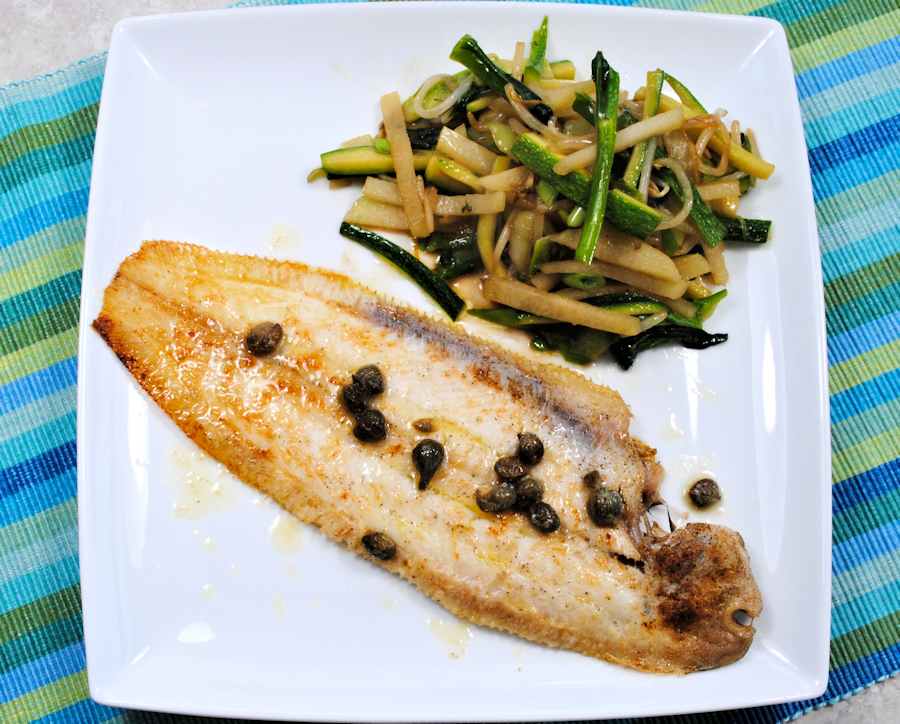Dover sole is at its most wonderful best when skinned and simply grilled, with lashings of butter and a few capers.

How to best cook Dover sole?
If turbot is the king of fish, Dover sole surely must be the queen. It’s actually easier to cook than turbot, which is a big beast and there’s always a quandary what to do with it.
Is it better to roast it whole? Or chop it into quarters, on the bone? Or fillet it and lose some of the flavour, and quite a bit of the expensive flesh even if it's expertly done?
With Dover sole there’s no problem. Cooked simple, grilled on both sides, served with caper butter is definitely outstanding.
Plus, the best thing about the sole is you can’t really spoil it. Even when slightly overcooked it will still be firm but delicate and succulent.
Many ways to skin a sole
I always cook sole skinned because it just looks so pleasing with the white flesh exposed, slightly scorched from all that butter, with capers dotted all over on a plate. And Dover sole skin is not great to eat, even for crisp fish skin connoisseurs like me.
You can buy your fish skinned in the supermarket or ask your fishmonger to do it, but skinning a Dover sole is actually quite easy.
You should first cut off the long dorsal fins on both sides with a pair of scissors. Then make an incision in the skin at the tail end, insert the knife underneath to get purchase and then just pull it off with a piece of paper towel for a better grip.
You can cut heads off or not, just make sure you don’t cut off too much flesh – it's the plumpest close to the head.
If you'd rather cook the sole with the skin on, no problem. Trim the fins as above and adjust the cooking time to about 6-7 minutes on each side, depending on the size of course.
Not all soles are the same
Apart from the Dover the queen of soles, also known as common sole, named from where it used to be fished the most abundantly, there is a lemon sole and a much rarer megrim sole. The family of flatfish includes plaice and flounder too, though none of them are as prized as the Dover.
Sole is a sustainable, not only a healthy choice and it is plentiful in Cornish waters.
Do not try skinning lemon sole though. I tried once and I did eventually succeed, but the experience bore resemblance to pulling teeth with bare hands.
When I told my fishmonger about it he fell into a tray of kippers, laughing. They share the name, those two soles, but don’t succumb to the same treatment.
What makes a Dover sole the tastiest?
Butter, butter and more butter – that's the key to tasty grilled fish. That actually applies to lemon sole too – cooked with SKIN ON – and plaice, John Dory, flounder or brill. I melt butter in a small pan and brush the fish all over, then baste it again during the cooking.
Depending on the size to a certain extent, skinned Dover sole needs 5 minutes on each side under hot grill.
A very large fish, over 350g, should be cooked for a minute longer on each side. If you want to share it, you’re in for a treat: Dover sole is fantastically easy to fillet and portion onto individual plates.
Dover soles are like wine
And an interesting fact about Dover soles – they need aging. Unlike most fish, those are the tastiest having lounged around in the fridge for a few days.
That's also when the skin will come off more easily, which makes perfect sense: after all ‘aging’ is the initial phase of breaking down the tissue. Though we’d rather not think about it like that, and no surprise!
More grilled fish recipes
Sea bream and sea bass, those two fishes we can never decide which one of them is better, can be grilled whole unless really enormous. Grilled balsamic bream recipe will work with bass as well.
There are some fancy ways to prepare salmon but simple grilled fillets are sometimes just what we need.
Mackerel is inexpensive and super healthy; also super easy to cook, grilled with a spice crust.
More sole recipes
Lemon or Dover sole fillets in creamy Parmesan sauce are an easy and elegant dish.
You can also roast the whole lemon or Dover sole, skin on, on a bed of sliced lemons and herbs.